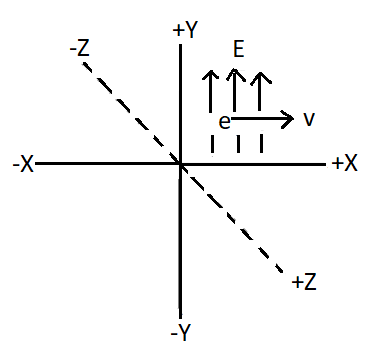
An electron is moving along +x direction with a velocity of $6 × 10^6\,ms^{–1}$. It enters a region of the uniform electric field of 300 V/cm pointing along +y direction. The magnitude and direction of the magnetic field set up in this region such that the electron keeps moving along the x-direction will be
A. \[3 \times {10^{ - 4}}{\rm{ T}}\], along –z direction
B. \[5 \times {10^{ - 3}}{\rm{ T}}\], along –z direction
C. \[5 \times {10^{ - 3}}{\rm{ T}}\], along +z direction
D. \[3 \times {10^{ - 4}}{\rm{ T}}\], along +z direction
Answer
218.4k+ views
Hint:Suppose any charge q is moving in the direction of the positive x- axis with velocity v. Because of charge moving an electric field exists around it. This electric field will apply a force on the charge whose magnitude will be qE in the direction that depends on the nature of the charge. If you assume the charge as positive. The electric field is trying to change the direction of the charge as it applies a force. To set up a magnetic field in the region to stop the direction of the charge. The net force must be in the opposite direction of the electric field.
Formula used
Force due to electric field,
\[{F_e} = q\overrightarrow E \]
Force due to magnetic field ,
\[{F_m} = q\overrightarrow {{\rm{ }}v} \times \overrightarrow B \]
In cross product, \[\widehat i \times \overrightarrow k = - \widehat j\]
Complete step by step solution:
Given velocity is along +x direction and the uniform electric field of 300 V/cm pointing along +y direction.

Image: Three dimensions of charge e moving
To calculate the direction of the magnetic field:
Force due to electric field is applied in the direction of \[\widehat j\],
\[{F_e} = q\overrightarrow E \]
Force due to the magnetic field must be in the opposite direction of the same magnitude as \[ - \widehat j\] ,
\[{F_m} = q\overrightarrow {{\rm{ }}v} \times \overrightarrow B \]
Thus
\[\begin{array}{l}\overrightarrow v \times \overrightarrow B = - \widehat j\\\widehat i \times \overrightarrow B = - \widehat j\\\widehat i \times \overrightarrow B = \widehat i \times \widehat k\\\overrightarrow B = \widehat k\end{array}\]
Therefore the direction of the magnetic field set up in this region will be along +z direction.
To calculate the direction of magnetic field:
Equating the magnitude as
\[{F_m} = {F_e}\]
\[qvB = qE\] (The charge of electron must be canceled)
Given velocity = $6 × 10^6\,ms^{–1}$
uniform electric field = 300 V/cm = \[3 \times {10^4}V/m\]
Substituting the value, we get
\[B = 5 \times {10^{ - 3}}T\]
Therefore the magnitude of the magnetic field set up in this region is \[B = 5 \times {10^{ - 3}}T\].
Hence option C is the correct answer.
Note: A Moving electron produces a magnetic field around it. Electric fields and magnetic fields are also known as electromagnetic fields or simply EMF. Which consist of waves of electric and magnetic energies moving together.
Formula used
Force due to electric field,
\[{F_e} = q\overrightarrow E \]
Force due to magnetic field ,
\[{F_m} = q\overrightarrow {{\rm{ }}v} \times \overrightarrow B \]
In cross product, \[\widehat i \times \overrightarrow k = - \widehat j\]
Complete step by step solution:
Given velocity is along +x direction and the uniform electric field of 300 V/cm pointing along +y direction.

Image: Three dimensions of charge e moving
To calculate the direction of the magnetic field:
Force due to electric field is applied in the direction of \[\widehat j\],
\[{F_e} = q\overrightarrow E \]
Force due to the magnetic field must be in the opposite direction of the same magnitude as \[ - \widehat j\] ,
\[{F_m} = q\overrightarrow {{\rm{ }}v} \times \overrightarrow B \]
Thus
\[\begin{array}{l}\overrightarrow v \times \overrightarrow B = - \widehat j\\\widehat i \times \overrightarrow B = - \widehat j\\\widehat i \times \overrightarrow B = \widehat i \times \widehat k\\\overrightarrow B = \widehat k\end{array}\]
Therefore the direction of the magnetic field set up in this region will be along +z direction.
To calculate the direction of magnetic field:
Equating the magnitude as
\[{F_m} = {F_e}\]
\[qvB = qE\] (The charge of electron must be canceled)
Given velocity = $6 × 10^6\,ms^{–1}$
uniform electric field = 300 V/cm = \[3 \times {10^4}V/m\]
Substituting the value, we get
\[B = 5 \times {10^{ - 3}}T\]
Therefore the magnitude of the magnetic field set up in this region is \[B = 5 \times {10^{ - 3}}T\].
Hence option C is the correct answer.
Note: A Moving electron produces a magnetic field around it. Electric fields and magnetic fields are also known as electromagnetic fields or simply EMF. Which consist of waves of electric and magnetic energies moving together.
Recently Updated Pages
Young’s Double Slit Experiment Derivation Explained

Wheatstone Bridge Explained: Working, Formula & Uses

Chemical Properties of Hydrogen - Important Concepts for JEE Exam Preparation

JEE General Topics in Chemistry Important Concepts and Tips

JEE Atomic Structure and Chemical Bonding important Concepts and Tips

JEE Amino Acids and Peptides Important Concepts and Tips for Exam Preparation

Trending doubts
JEE Main 2026: Application Form Open, Exam Dates, Syllabus, Eligibility & Question Papers

Derivation of Equation of Trajectory Explained for Students

Hybridisation in Chemistry – Concept, Types & Applications

Understanding the Angle of Deviation in a Prism

Understanding Collisions: Types and Examples for Students

Understanding Atomic Structure for Beginners

Other Pages
JEE Advanced Marks vs Ranks 2025: Understanding Category-wise Qualifying Marks and Previous Year Cut-offs

How to Convert a Galvanometer into an Ammeter or Voltmeter

Understanding Centrifugal Force in Physics

Ideal and Non-Ideal Solutions Explained for Class 12 Chemistry

Degree of Dissociation: Meaning, Formula, Calculation & Uses

Understanding Electromagnetic Waves and Their Importance




